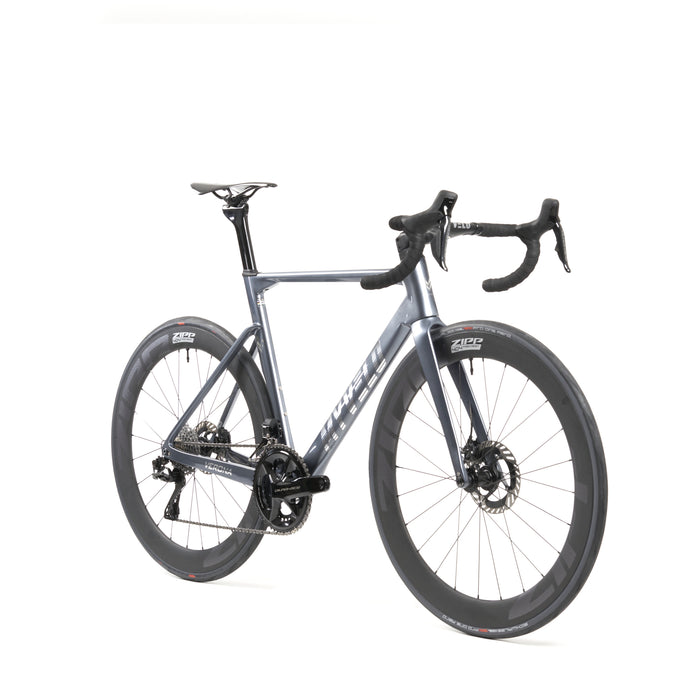
Verona road bike
incl. FREE shipping & free returns

The Functional Threshold Power (FTP) test is an essential tool for ambitious road cyclists who want to take their performance to the next level. FTP indicates how much power (measured in watts) you can consistently produce over an hour without fatigue. This value serves as the basis for training zones, race strategies, and performance analysis.
Von Fabian Huber |
3 minutes read time

FTP is the maximum level of sustained power you can maintain over 60 minutes. It reflects your anaerobic threshold, the point at which your body begins to produce more lactate than it can eliminate. A high FTP means you can ride longer and at a higher intensity — a decisive advantage, whether in an individual time trial or on long climbs.
There are two common approaches:
60-minute test
The classic: Here, you pedal as hard as possible for an hour. Your average power output corresponds to your FTP. However, this test is extremely physically and mentally demanding.
20-minute test
A more common variation involves performing maximum effort for 20 minutes. Your FTP is calculated by taking 95% of the average power output for this interval.
Example calculation:
Average power (20 min): 280 watts
FTP = 280 x 0.95 = 266 watts
To ensure that your test provides a realistic picture of your performance, thorough preparation is essential:
Functional Threshold Power (FTP) is not a static value – it can fluctuate considerably due to external influences. Even small changes in the surrounding conditions can distort the test results. Sleep, nutrition, stress levels, and the time of the test in the training cycle are particularly relevant. For example, someone who goes into the test deprived of sleep or with depleted glycogen stores will hardly be able to achieve maximum performance. Environmental factors such as temperature, humidity, and altitude also play a role: In extreme heat or thin air, performance drops measurably. Even the time of day can play a role – many athletes reach their peak performance in the afternoon rather than early in the morning. To obtain meaningful values, testing should therefore be carried out under as consistent conditions as possible.

The FTP is the starting point for determining training zones:
With these zones, you can tailor your training to improve weaknesses and efficiently increase your performance.
FTP is much more than just a number – it is the foundation for targeted and effective training planning. Training zones (such as basic endurance, threshold training, or VO₂max intervals) can be precisely defined based on your individual threshold performance. This ensures that each session provides the desired training stimulus – not too easy, but not too demanding either. FTP plays a key role, especially in interval training, as intensities are often controlled as a percentage of your threshold performance. Regularly checking and adjusting your FTP allows you to continuously optimize your training and objectively measure progress. Training platforms such as Zwift, Wahoo SYSTM, and TrainerRoad also use FTP as the basis for dynamic training plans that automatically adapt to your individual performance level.
Every 6-8 weeks is a good rhythm for documenting progress and making training adjustments. It's especially worthwhile to check your FTP regularly during competition preparation.
An FTP test is the perfect tool for controlling your training intensity and measuring progress. It helps you specifically improve your performance and reach your full potential. Whether you're a recreational cyclist or a serious road cyclist, structured training based on your FTP will help you become faster, stronger, and more enduring. 🚴💨
Have you tested your FTP yet? Share your experiences and tips in the comments! 😊

Wer regelmäßig mit dem Rennrad unterwegs ist, kennt das Ritual: Nach einer langen Ausfahrt oder vor einem knackigen Intervalltraining führt kein Weg am Espresso vorbei. Ob in der italienischen Bar an der Strecke, auf dem Marktplatz nach dem Sonntagstraining oder zuhause aus der Siebträgermaschine – der Espresso ist fester Bestandteil der Rennradkultur. Doch was steckt hinter dieser Verbindung aus Koffein, Stil und Leistung?

Wer an Rennradfahren denkt, hat oft Bilder von durchtrainierten Beinen, kraftvollen Antritten und aerodynamischer Haltung im Kopf. Doch ein Muskel spielt eine unterschätzte, aber entscheidende Rolle: der Beckenboden. Er ist nicht nur für Stabilität und Körperkontrolle wichtig, sondern auch für Komfort, Leistungsfähigkeit – und die langfristige Gesundheit auf dem Rad.

Die Auswahl an Fahrrädern war noch nie so groß wie heute. Rennrad, Mountainbike oder doch ein Gravel Bike? Jedes dieser Bikes hat seinen eigenen Charakter, seine Stärken und idealen Einsatzbereiche. Doch wo liegen die Unterschiede – und welches Rad passt am besten zu Dir und Deinem Fahrstil? In diesem Artikel erfährst Du, was die drei Bike-Typen auszeichnet, welche Vor- und Nachteile sie haben und worauf Du bei der Entscheidung achten solltest.